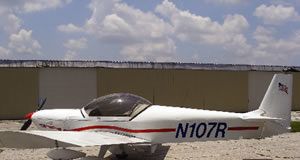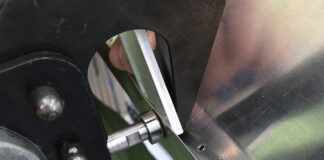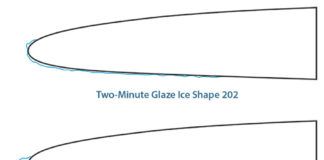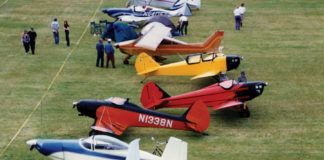As a kit company, Lancair has remained true to a specific course: create airplanes that are fast and sexy. Fast comes from a lot of power, sexy comes from the composite curves. When the Lancair IV arrived in the early 1990s, it was a hot rod by any standard. With 98 square feet of wing on a 2900-pound airplane, it demanded respect from its pilots. Pressurization necessitated air conditioning, then more fuel, and then came a turbine engine. The IV platform evolved to and beyond its natural limits, and it’s fair to say the Propjet is more burdened by more compromises than most. To move forward, Lancair had to start again.
Joe Bartels acquired Lancair International from founder Lance Neibauer in 2003. “We knew from day one there had to be another product,” Bartels said. “The IV-P was a great airplane, but it was on the other side of prime.” While stopping short of saying that the airplane was too hot to handle for the average customer, Bartels acknowledged that the company needed an airplane that could be flown comfortably by the average pilot in the target market. “It takes a current pilot to fly the IV. It was time for a change.”
The “change” is called the Evolution, and the mockup was revealed at AirVenture 2007, carrying a $250,000 base kit price and an estimated finished price of $650,000 to $1 million. Sans wings and tail, the mockup looked disproportionate, and the round windows had the essence of Charlie Brown’s Snoopy. First flight was on March 21, 2008.
The Evolution arrived at AirVenture ’08 with a slick paint scheme and a one-piece windshield. Snoopy was returned to the doghouse, and the now much more compelling Evolution was greeted by oohs and aaahs.
It’s worth noting that the airplane is a prototype and is therefore a work in progress. Many of the systems are in need of fine-tuning, and while the pressure vessel has been tested, the airplane has not been flown pressurized. Therefore, this is not the definitive flight report of a finished product. Instead, it’s the premiere look into the potential of this exciting new airplane.
Fabric of Society
Composite design allows airplanes to slip through the air. If there is a flat piece of skin anywhere on the airplane, I never saw it. Lancair General Manager and Evolution designer Tim Ong is a mechanical engineer who specialized in fluid dynamics, and it shows. The airplane looks as though it would barely disturb the air molecules as it nudged them aside and then neatly put them back where they were.
The airplane appears at peace with the pilots and passengers as well. The mockup was appointed with an interior suitable for a luxury automobile with adequate room for four normal size adult passengers. Headroom, shoulder and elbowroom are spacious in the front and comfortable in the back. Legroom is excellent for all.
A spacious cabin is of no use without payload to support it. The target empty weight for a fully equipped airplane is 2350 pounds with a gross weight of 4300. Full fuel is 1132 pounds, leaving just more than 800 for the cabin. That means it should be able to fill the seats and the fuel tanks—a rarity, particularly in turbine equipment.
Sampling the Systems
The prototype is outfitted with a two-screen Garmin G-900X system with synthetic vision and a touchscreen panel in the center called ACES (aircraft control and environment system). That system controls nearly all other functions and related electronic circuit breakers. A small panel of conventional circuit breakers located on the front of the spar will be moved to the space between the seats for easier access on subsequent models. Five rocker switches and the gear switch on the glare shield make for a remarkably clean and uncluttered cockpit.
The autopilot is a TruTrak Sorcerer. A yaw damper is planned instead of rudder trim. Light airplanes with large engines require substantial rudder trim adjustments with power and speed changes, and here the electric elevator and aileron trim are controlled by a “coolie hat” on the side stick. The landing gear is electric/hydraulic, and three identical actuators move it up and down. An internal collar inside these cylinders locks the gear down using balls that fall into a groove. Think of the locking mechanism in an air hose coupler. Hydraulic pressure holds the gear up, and releasing the pressure drops the gear in the event of a malfunction.
The maingear is trailing link, and the link is attached to a massive triangular trunnion. The gear sports the same tire as on the nosewheel of a T-38 Talon military jet. The nosewheel on the Evolution is a 500×5 conventional general aviation tire and casters with rudder and differential braking.
The wings are almost entirely wetted and hold 84.5 gallons each. The prototype has a manual left/right/off fuel selector, but in the final kit this will be an automatic system that switches from left to right automatically on a 10-minute timer. If a low-fuel light comes on, the system will switch to the other tank until both low-fuel lights are on, and then cycle once a minute. Why the fuss? Turbine engines need an uninterrupted supply of fuel, and the automatic system should ensure that nearly all fuel available will be continuously supplied to the engine until it’s gone.
A proprietary natural laminar airfoil concludes with Frise type ailerons and Fowler flaps. The ailerons are actuated by push-pull tubes, and the flaps are deployed by electric screw jacks. The elevator is also controlled by push-tube controls with a conventional trimtab. The rudder is actuated by cables, but rather than attaching to conventional bell cranks at the bottom of the rudder (a configuration that changes geometry with deflection), the rudder cable wraps around a capstan that maintains consistent deflection geometry with pedal movement. The elevator and aileron controls pass through the cabin bulkhead via bell cranks and bearings instead of control boots, which increase friction in the control system and are a perpetual source of cabin leaks.
The pressurization system was not yet installed, but cabin pressure will be electronically managed by the ACES controller. The planned 6.0 psi differential will yield an 8000-foot cabin altitude at FL280.
Say Hello to My Little Friend
The Evolution prototype has a Pratt & Whitney PT6A-135A. This is a 750-horsepower version of the most popular turboprop engine of all time. PT6s come in three sizes: small, medium and large. There are several dash numbers in each group, and the -135A is considered to be the best in the medium-size group. It has a high-torque gearbox, which allows high power at lower and quieter propeller speeds.
For piston-aircraft pilots the most challenging part of flying the Evo is likely to be engine start. The before-start checklist is brief, and the switches on the glareshield are turned on in order: master, fuel pump, ignition and start. When the N1 stabilizes, move the condition lever over the gate to introduce fuel and monitor the inter-turbine temperature (ITT) for a hot start. When the engine is running, turn the starter off, un-feather the prop, and move the condition lever forward to 1200 rpm.
The Evolution has a four-blade metal prop that is susceptible to a resonance problem when operating between 400 and 1200 rpm in a tailwind condition. Above 1200 rpm, the generator can be turned on and you’re ready to taxi. Turbine airplanes have nice features called “beta” and reverse. Beta moves the propeller blades to flat pitch, which stops the prop from making thrust, while reverse actually reverses the blades and adds power. Because of the big engine and small airplane, all taxiing is done in beta or reverse. The Evolution power quadrant is a well engineered, precision piece of machinery. It has a smooth feel with some innovative interlocks to prevent inadvertently selecting beta or reverse. Taxiing is easy with only braking used for steering. The rudder is effective at low power and, unlike some piston-powered airplanes with castering nosewheels, hot brakes should never be an issue.
With the runup complete, we took the runway, brought the power up to 80% N1, checked the engine temps and pressures, released the brakes and pushed the power up to 1250 foot-pounds of torque. At 1900 rpm, that equates to about 450 hp—well below the 500-hp takeoff limit.
Without interior pressurization, air conditioning, de-icing and several other amenities, the prototype Evolution is light; fully furnished, it will surely weigh more than the current 2200 pounds. With 400 pounds in the cabin and only 50 gallons of fuel, our weight was low. Nearly 500 hp on a 2900-pound airplane is a good ride. Rudder deflection is required to counteract torque, but the forces were less than I expected. The airplane leapt into the air, and as soon as the gear and flaps were retracted, we could push the power up beyond the takeoff limit.
The engine rigging was not complete, and the engine power was not limited by torque or temperature—as is usually the case—but rather by the travel of the power lever. Trimming up the engine controls required running the engine at full rated power on the ground. Ong and the Lancair crew have yet to determine how to secure the airplane to the ground for a full-power ground run.
With the power lever at the firewall, temps and torques were far below redline. That information hides easily among all the data displayed on the G-900, but after a few flights it would most likely become second nature. With the power pulled back to 1300 foot-pounds of torque at 120 KIAS the airplane climbed at 3000 fpm.
Getting Outta OSH
We left the crowds and the traffic of Oshkosh and moved over to Sheboygan, Wisconsin, (KSBM) on the east side of Lake Winnebago. I asked Ong if he had any concern about crossing the 10 miles of water in the lake. He smiled and said it was not a problem. I would later find out why.
At Sheboygan, Ong took the airplane to demonstrate a landing. On downwind he selected gear down, set approach flaps, and slowed to 100 KIAS. I started to squirm. While the nose was not high, it seemed much too slow. On base, with full flaps he slowed to 85 KIAS, and I was fidgeting. The airplane was rock solid as he slowed to cross the numbers at 75 KIAS. Even so, I sat on my hands to keep from reaching up and adding power, but the speed was right and we touched down smoothly in the paint. A little reverse and we stopped quickly.
We reconfigured for takeoff, and I took the airplane. Already I was learning where to look for torque and temperature, and before I had the power set, the airplane was climbing skyward at an alarming rate. From a stop-and-go landing, we were at pattern altitude crossing the end of the runway with a huge power reduction to keep the speed under control, and it was my turn to land.
The speeds that seemed too slow when I was watching the landing seemed just right with my hand on the stick. I matched Ong’s smooth arrival in the touchdown zone. “Even though the speeds feel right, they seem too slow,” I said. “If you are a few knots hot, that long wing will float forever,” he replied. I believe him.
Some turbines have the low pitch stops set low to keep taxi speed under control. These airplanes will fall out of the sky when the throttles are closed, making landings an interesting proposition of precisely finding the spot with minimal power that keeps the prop pulling instead of becoming a barn door—in turn blanking the center of the wing and all of the tail. I don’t know whether it is the 1200-rpm idle speed required by the prop harmonic or the setting of the low pitch settings, but this airplane lands beautifully at idle power.
Air Work Made Easy
We refueled with 100 gallons of Jet A and departed Sheboygan. At 8500 feet we slowed the airplane and dropped the gear and flaps for some stalls and slow flight. Our weight was now 3200 pounds. Ong demonstrated power-off stalls at 56 knots indicated with a 2- to 3-knot noticeable aerodynamic warning. Half-flap stall was at 65 KIAS, and with flaps up it unhooked at 75 KIAS with the same warning.
It was my turn, and I repeated the exercise. As the speed slows the airplane gets a little “roll-y,” but it is easily controllable. At the stall I had full aft stick and held it. The airplane was totally controllable in roll with either the ailerons or the rudder; as it broke the nose dropped slightly, and I held the stick back. The nose came up and it broke again, just like a Cherokee 140. The speed was creeping up as was the descent rate, but absolutely no bad habits were apparent. Steep turns were intuitive, and while the ailerons are heavier and the rudders are lighter than I would like, they are probably just about right for an IFR cross-country cruiser. Yaw damping will be nice, but only because it is a replacement for trim. The airplane has no tail-wagging tendencies that I noticed.
Thermaling, Anyone?
Over the airport Ong explained the reason he wasn’t worried about crossing the small lake in an Experimental prototype. We slowed the airplane, and he feathered the propeller. He told me to maintain best glide speed of 110 knots. After some speed oscillations the VSI settled down to 600 fpm.
This was the most incredible thing I had seen yet. Think about it. That is less than 300 feet of altitude lost per statute mile. That’s a 22:1 glide ratio. I was tempted to start looking for thermals. At a typical cruise altitude of 25,000 feet, say 22,000 above the high key for a dead-stick overhead approach at most airports in America, the airplane might glide for as long as 30 minutes; at 110 knots that is 55 n.m. Granted, we were flying an airplane well below gross weight without interior, air conditioning and pressurization, but it is still an incredible feat. Not only was the low descent rate impressive, the best glide speed of 110 knots is a nice low number that can be easily transitioned into a dead-stick landing without superhuman pilot skills.
With the bottom end of the envelope studied, we climbed to look at the top end. The flutter analysis was not yet complete, and Lancair has limited the airplane to a 210 KIAS Vne instead of the anticipated 255 KIAS. Moreover, without oxygen we were limited to 14,000 feet. We climbed there quickly and pointed the airplane into the wind until the velocity vector on the G-900 matched the heading indicator, showing that we were pointed directly into the wind. The limited power available from the power lever rigging gave us only 1300 foot-pounds of torque, and that gave us our 210 KIAS max airspeed, which yielded a 247-knot groundspeed. A 180 turn downwind made the groundspeed 285 knots for an average of 266 KTAS. Without a lengthy explanation of the extrapolation of those numbers, it is reasonable to expect that the Evolution will cruise at well over 300 KTAS. Officially, Lancair is sticking to its original estimates of 330-knot max cruise (at a claimed 39 gph) and 270-knot economy cruise (at 23 gph).
In the few minutes at altitude, Ong and I were feeling the effects, and we hurried back down. While the airplane might be a glider with the propeller feathered, with the prop in low pitch and the power back, it falls like a brick and we were quickly back in breathing altitudes. That’ll come in handy when ATC demands a “slam dunk” approach, as will the Evolution’s ability to keep up the pace in front of fast traffic. For that matter, max gear extension speed (Vlo) is a usefully high 180 KIAS—10 of flaps can come out at 160 KIAS. Good stuff.
Where to from Here?
The Evolution is a work in progress, but the result is clear: It has great manners at slow speed without sacrificing the top end. Lancair has subjected the airplane to an FAR Part 23 test card and claims it meets those handling criteria. Based on the parts of the envelope I sampled, I see no reason to question that claim.
Lancair has said all along, during the protracted development process, that the Evolution would take up where the IV-P and the Propjet left off, to begin the journey well out of the growth-limited envelope of the earlier design. From what I’ve seen, it’s off to a fine start.
For more information, call 541-923-2244, or visit www.lancair.com.




